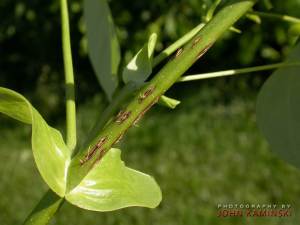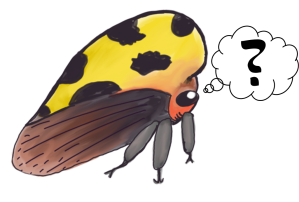Written by Joe Ballenger
Today’s question comes from Trevor Knight, via our Facebook page. He wants to know if it’s possible to rear cicadas in captivity. It’s a good question, and one I’ve been curious about myself.
Insect rearing is something that’s deceptively difficult. There are lots of insects which are in the pet trade, but these are fairly easy insects to rear for a number of reasons. Some, like crickets, cockroaches, and mealworms, eat stuff that’s already in the houses of most people. Others, like tarantulas, mantids and assassin bugs, eat things which can be easily procured from stores.
Unfortunately, cicadas probably don’t fit into the easy category. However, I think a persistent and disciplined keeper would be able to rig something up.
Cicada Biology
To understand why I believe cicadas would be difficult to work with, I think it’s a good idea to consider their biology. The video above from Life in the Undergrowth gives us a great starting point. These are large and long-lived insects which live underground for a long time. The species shown in the video, the periodical cicada, is an exceptional example of insect longevity because it has a lifespan of 13-17 years depending on the species. Most cicadas live about 2-3 years, so most species wouldn’t be like raising a kid. Instead, it would be more like raising a tarantula.
There’s a couple important things the above video didn’t explain, however.
- Cicadas live on a nutrient poor liquid diet. Trees have two kinds of sap: nutrient rich phloem, and nutrient poor xylem. Cicadas live on xylem, which means they need to constantly eat huge quantities of food. Some xylem feeding insects can eat 3x their weight in food every day.
- Cicadas need twigs to lay eggs in, and these twigs probably need to be living.
So with this stuff in mind, there’s two routes you could go…one of which would probably be much more difficult than the other.
Artificial Diet
I’m going to tackle Mr. Knight’s second suggestion first. He suggested feeding them artificial diet from a bowl, which is kind of how most fluid feeding insects are fed in captivity. Most fluid feeding insects are fed through a membrane, which mimics the host’s outer surface the insect needs to pierce through.
The University of Wisconsin has a really good how-to video on how to set up a membrane feeding system for ticks. Cicadas don’t feed on blood, but the concept is the same. Insects tend to drown if there’s liquid water in their captive environment, so they’d need to be separated from the diet. They also probably wouldn’t recognize free-standing liquid as food.
To feed the insect, you’d also need some sort of artificial diet. I’m not aware of any which have been developed for cicadas, although I know that artificial diets have been developed for other Hemipterans such as the Tarnished Plant Bug. Unfortunately there’s no way to know if the published Hemipteran diets would be useful for cicadas in general, or the specific cicada Mr. Knight would be interested in working with.
Artificial diets can be tricky, though. They rely on the inherent flexibility of insect metabolism, and try to ape the nutritional profile of a host organism by using components which are more readily available, more easily stored, or cheaper than the host plant. There’s a lot of trial and error involved to create a diet that could rear insects through multiple generations. It could be done, but it would be a major project.
Other than the nutritional profile, you’d need to replicate the texture or consistency of the natural diet. This isn’t something that a lot of people would immediately think about, but it’s a pretty important part of cuisine. A whole hamburger is delicious, but a hamburger smoothie isn’t exactly appetizing.
The final thing to consider is contamination. Xylem feeding organisms eat a lot to make up for their poor diet, and this means that they’re going to poop a lot. Fluid feeding insects tend to have liquid poop that turns sticky when it dries. This means that the cicada could get stuck in it’s own poop, which would require constant cage cleaning that would be stressful on the insect. It would also be a breeding ground for contamination.
I think using an artificial diet would be possible, but it would be very difficult to develop an artificial diet and a container which would be low-maintenance for the bug.
Instead I favor a second method…
Host Plant

Annual cicada, Tibicen sp., which has a beautiful camoflauge motif.
Picture credit: Mary Kelm. License: CC-BY-NC-SA-2.0
In the wild, cicadas feed on xylem from tree roots. Using a host plant would be a bit more natural, because the plant would synthesize the cicada’s diet. The annual cicadas most commonly encountered by people in the US, Tibicen, feeds on plants which can be acquired as seedlings from nurseries. A little bit of trial and error would be required to figure out which host trees would grow best indoors, but this would be simple compared to creating an artificial diet. It would also be much cheaper.
That’s not to say there wouldn’t be challenges using host plants. If you wanted to actually watch your pet develop, you’d need to build a viewing window into the side of the pot and convince the cicada to feed there. You’d also need the insect to establish in the first place, and the available literature suggests this is a serious issue. One paper in which researchers gathered eggs and attempted to transfer them in captivity found that 95% of the newborn nymphs died before finding food.
Yeah, it’s hard for a bug out there. Even in captivity.

Cicadas lay their eggs in twigs, and the scars look a bit like this.
Picture credit: John Kaminiski. License: CC BY-NC-ND 2.0
You’d also need to find the eggs in large amounts, which can be difficult because they’re well hidden. The adults lay their eggs in slits in twigs, so you’d need to actually find a lot of cicada nests. This is easy for a species with high densities like periodical cicadas, but a bit more difficult for most other species.
The Bottom Line
Cicadas have a reputation for not doing well in captivity, but I think this is because they’re not usually big economic pests (see citations for an exception). Creating rearing protocols is time consuming and kind of expensive. Because they’re not big economic pests, there’s not a big incentive to create rearing protocols.
You could try rigging up a membrane feeding system with an artificial diet, but I think this would be difficult for a casual keeper. Instead I think it would be easier to raise the insect on a host plant by gathering eggs and letting them hatch into the pot.
After those eggs hatch, though…I’m not sure how you’d get them to establish. The stuff I’ve read on the topic implies you’d need a Law of Large Numbers approach: get as many eggs as you can, and hope a few survive.
I think it’s possible. It’s not easy, but it’s possible.
Good luck, and if you have success…let us know!
Works Cited
Logan, David. “Nymphal Development and Lifecycle Length of Kikihia Ochrina (Walker) (Homoptera: Cicadidae).” The Weta 31 (2006): 19-22.
Itô, Yosiaki, and Masaaki Nagamine. “Why a Cicada, Mogannia Minuta Matsumura, Became a Pest of Sugarcane: An Hypothesis Based on the Theory of ‘escape’.” Ecological Entomology 6.3 (1981): 273-83.
Nagamine, Masaaki, Rinko Teruya, and Yosiaki Itô. “A Life Table OfMogannia Iwasakii (Homoptera: Cicadiidae) in Sugarcane Field of Okinawa.” Researches on Population Ecology 17.1 (1975): 39-50.
White, Joann, and Charles E. Strehl. “Xylem Feeding by Periodical Cicada Nymphs on Tree Roots.” Ecological Entomology 3.4 (1978): 323-27.



Thank you so much for this informative & interesting page on your website! That, as you said, artificial food & a membrane system can pose challenges for the casual Cicada-pet-keeper, as a homeschooling mommy of 3 (I have my PhD & M.S., by the way!), we deduced (from the info you published, here), & decided to try, a thing that so far has worked beautifully for 159 days for my kids’ Cicada in captivity: we cut strips of Bounty brand paper towels, lay a glob of Mrs. Butterworth pancake syrup on one end of each strip (the syrup is loaded with maple & corn syrups), & then we roll up the saturated strips & deposit them into the Cicada’s receptacle… The Cicada will latch on to the syrup-sticks & suck them dry… 2 sticks saturated with a syrup volume arguably 1.5 x the weight of the Cicada does seem to be the Cicada’s consumption limit daily… We have photos if you want them! At risk for anthropomorphizing a Cicada, our Cicada SINGS & will chirp (as if in greeting), & is otherwise quiet unless / until my kids engage with it. I do clean out the Cicada receptacle every other day (swab with a mineral water soaked cotton ball twirled onto the end of a disposable chopstick), & every 4-5 days we transfer the Cicada to a disposable cup (with whatever syrup-stick unto which it is latched) & give its receptacle a good scrub & rinse with Dawn dishsoap… You are welcome to reach us — especially if I may be of service as a VOLUNTEER Grant Writer or if I may help you, as a volunteer, to start a non-profit (25+ award-winning years serving non-profits & start-up non-profits)!
LikeLike
I have an adult one that has injured wings. What would I feed it?
LikeLike
Wasps can be fed on a mixture of honey and water…usually a 5:1 dilution of water:honey.
LikeLike
Maple syrup would be fine.
However, it might be best to try to get a potted tree from a local garden store. Membrane feeding systems can be tricky to rig up.
LikeLike
What a fascinating post! Brilliant approach to feeding and care. I was trying to find information about whether cicada nymphs move around as they grow – or just stay latched onto a decent food supply for their entire underground existence. Your post indicated that your friend chirps. Which made me wonder what stage of life it is. I can’t imagine a nymph being very vocal. But assume an adult, if it eats, would not be so easy to transfer between receptacles. Great to read your post! Thanks for posting it.
LikeLiked by 1 person
So I can feed my adult cicada syrup?
LikeLike
This depends on what species you have. Maple syrup, the real kind, is concentrated xylem sap. Hypothetically, it should have everything the bug needs if you can rig up a proper membrane feeding system.
However, there are many cicadas which don’t feed on maple. So it depends on the species, and what plant species that insect lives on.
LikeLike
The Cicadas I just found in our yard was on a Maple tree so I’m going to give it a shot with Maple syrup. I was wondering if I could use a small sponge like we do with butterflies?
LikeLike
We had a big storm and collected a box of the dead and dying annual cicadas, now a week later there appears to be the tiniest nymphs in the container and I’m curious if there’s any way we could attempt to captive raise these critters. Has any further experimentation or study been done regarding this topic??
LikeLike